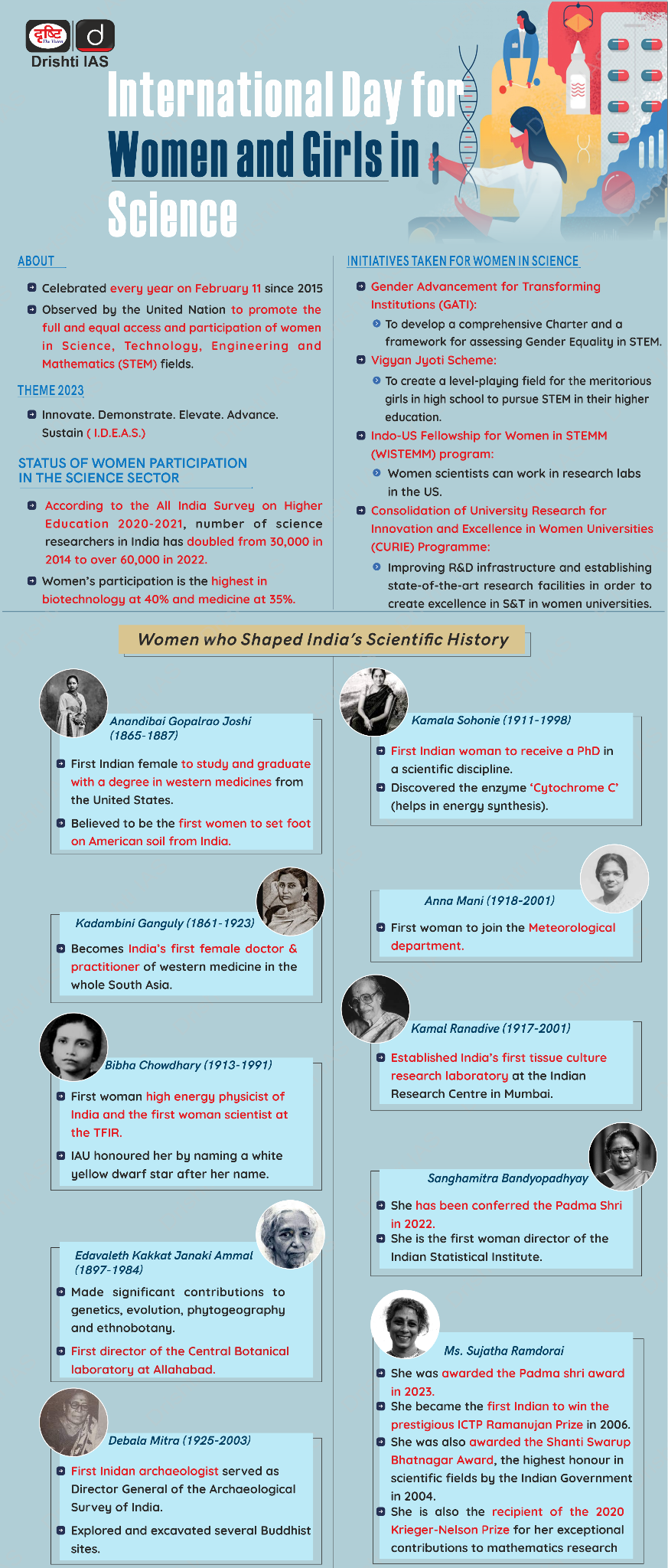Gender Gap in Indian STEM Faculties | 26 Apr 2024
For Prelims: STEM, Women in STEMM (WiS) Program, Vigyan Jyoti, International Day of Women and Girls in Science
For Mains: Underrepresentation of Women in Indian STEM, Policy Formulation about STEM Sciences, Education
Why in News?
A significant gender gap exists in Indian STEM(science, technology, engineering, and math) faculties, with a BiasWatchIndia study revealing that only 13.5% of faculty members across 98 universities and institutes are women.
- This underrepresentation is more prominent in India compared to countries like the US and UK.
Why is there a Gender Gap in Indian STEM Faculties?
- Social Bias Against Women in Certain STEM Fields: Fields like Biology, seen as "soft sciences," have higher female representation compared to hard sciences like Engineering and Physics.
- Societal biases discourage women from pursuing fields perceived as less feminine, affecting their choices in higher education and research.
- Lack of Support During PostDoc to Faculty Transition: The critical transition from postdoc to faculty often aligns with family planning, leading to difficult choices for women.
- Societal pressure prioritising family over career ambitions and a lack of support structures exacerbate the challenge.
- Toxic Workplace Environment: Many women exit STEM academia due to a toxic work environment.
- Factors include disrespect, inadequate access to resources, and limited advancement opportunities compared to male colleagues.
- Difficulty Accessing Gender Representation Data: Absence of a central database tracking women faculty in STEM across India.
- Lack of data hinders understanding of the gender gap and monitoring progress towards gender equality.
What are the Government Initiatives to Promote Women in STEM?
- Women in STEMM (WiS) Program: Launched by the Department of Science and Technology(DST), it provides scholarships, fellowships, and research grants to women in STEM. It also offers mentorship and networking opportunities.
- Vigyan Jyoti: It was introduced in 2019-20 to encourage meritorious girl students in classes 9-12 to pursue higher education and careers in STEM fields, addressing the underrepresentation of women in these areas.
- Developed by the Department of Science and Technology, it offers workshops, mentoring, and resources for young women in STEM.
- The program provides support from the school level to PhD level.
- Women in Science and Engineering-KIRAN (WISE-KIRAN): It encourages women scientists to pursue research in frontier areas of science and engineering and to address societal problems through S&T-based internship and self-employment opportunities.
- Many well-qualified women face challenges in participating in S&T activities due to circumstances typically associated with gender, such as career breaks due to motherhood and family responsibilities.
- To address these issues, the DST will provide opportunities for women scientists and technologists aged 27-57 who have taken a career break but wish to return to mainstream work.
What Steps can be Taken to Bridge the Gender Gap in Indian STEM Faculties?
- Flexible Work Arrangements and On-site Childcare: Offer flexible work schedules, part-time options, and on-site childcare facilities for female faculty members, particularly those with young children. This can help address work-life balance challenges.
- Programs like DST's WISE-KIRAN can be expanded to offer targeted support, such as childcare options and flexible work arrangements, to ease this crucial transition.
- "Back to Academia" Fellowships: Creating fellowship programs that support women who may have taken a break from academia to raise families, providing them with resources and mentorship to re-enter the research and teaching track.
- International Collaboration and Exchange Programs: Encouraging female faculty members to participate in international research collaborations and exchange programs, broadening their perspectives and research networks.
- Visibility and Recognition: Highlighting and celebrating the achievements of female faculty members through awards, public recognition, and media coverage. This boosts morale, inspires others, and promotes role models.
- Women Safety and Data-Led Development: Robust policies are needed in addressing workplace harassment and ensuring equal opportunities are crucial for retaining female talent.
- Data collection on female faculty can be incorporated to create a central database, enabling better-targeted interventions.
|
Drishti Mains Question: Q. Analyse the factors contributing to the underrepresentation of women in Indian STEM and evaluate the effectiveness of existing initiatives related to promoting women in STEM. |
UPSC Civil Services Examination, Previous Year Question (PYQ)
Mains
Q.1 “Empowering women is the key to control population growth”. Discuss. (2019)
Q.2 Discuss the positive and negative effects of globalisation on women in India? (2015)
Q.3 Male membership needs to be encouraged in order to make women’s organisations free from gender bias. Comment. (2013)

